AI systems operating independently, without the need for constant human insights to achieve defined goals, are no longer fiction; they are autonomous AI agents at play. Companies that have adopted them in areas like customer service are already seeing impressive results: resolving up to 80% of support issues without human reps and cutting operational costs by 30%. Curious about how to get started but not sure where to begin? This comprehensive guide on AI autonomous agents covers everything you need: types of autonomous agents, real-world examples, and more.
AI agents are driving the next wave of innovation and revolutionizing how businesses operate, with autonomous AI agents at the center of this revolution.
74% of organizations that have already collaborated with companies offering AI ML development services and invested in automation led by GenAI, autonomous AI agents, and more are already seeing their investment exceeding expectations, and 63% of them are already planning on increasing their investment by 2026. According to Accenture research, these organizations are already seeing 2.5X revenue growth, 2.4X productivity, and 3.3X success at scaling automation use cases compared to their peers.
As per other AI statistics, 82% of the organizations are planning to optimize their workflows by integrating AI autonomous agents within the next couple of years.
Clearly, the opportunity is massive, but unlocking it starts with understanding the capabilities, types, and real-world applications of autonomous AI agents. Let us break down what they are, how they work, and more.


What Are Autonomous AI Agents?
Autonomous agents are AI systems designed to work independently without the requirement of constant human oversight to achieve the specific goals. They perceive their environment, make decisions, and take actions independently to achieve defined goals. They use machine learning, reasoning, and planning to adapt and operate over time.
Some of the real-world examples of top autonomous agents are AutoGPT, Thomson Reuters CoCounsel, Fireflies.ai, and more.These are fully AI autonomous agents, while there are other ones as well that are semi-autonomous and just AI agents. Learn about agentic AI vs AI agent to further understand the differentiating aspects before arriving at a decision.
How Do Autonomous AI Agents Work?
Autonomous AI agents work by sensing their environment, processing information using AI models, making decisions based on goals or learned behaviors, and then taking actions. Let’s explore how AI autonomous agents work in detail.
Perception and data collection
Autonomous agents begin by observing their environment using sensors or input data streams. This is the stage where raw data is collected and interpreted to form a situational awareness or state representation.
In physical agents (e.g., robots), this involves sensors such as cameras, lidar, GPS, and microphones. In digital agents (e.g., software bots), this may include APIs, databases, web scraping, or natural language input. These agents also use machine learning models to identify patterns, predict outcomes, and refine the autonomous agent’s understanding of its environment.
The AI autonomous agent processes this information to “understand” its current state, including relevant environmental conditions, constraints, or changes.
Decision-making
Once the environment is understood, the autonomous agent determines the best course of action to take in order to move toward its specific goal.
This decision-making process may involve rule-based logic (if–then rules), search or planning algorithms (e.g., A*, decision trees), optimization techniques (e.g., utility maximization), machine learning models (reinforcement learning or predictive models), language models (in the case of LLM-driven agents), and more.
AI autonomous agents often use an internal model of the world to evaluate possible future states before selecting the most effective action.
Action execution
Upon choosing an action, the autonomous AI agent interacts with its environment to carry it out. This could involve physical actions, like moving or manipulating objects (in robots), or digital commands, like clicking buttons, making API calls, sending messages, or updating records (in software autonomous agents).
Action execution may require handling uncertainty, delays, or partial feedback, which the AI autonomous agent needs to manage in real time or asynchronously.
Learning and adaptation
To improve performance over time, autonomous agents developed by the companies offering AI agent development services typically incorporate some form of learning, such as reinforcement learning, supervised learning, unsupervised learning, few-shot learning, or in-context learning, depending on the types or learning requirements of the AI autonomous agents.
Learning enables the autonomous AI agent to adapt to new environments, optimize decision strategies, and recover from failure. In long-term deployments, this adaptability is essential to maintaining autonomy in dynamic conditions while improving performance.
The Rise of Autonomous AI Agent Development
The rise of autonomous AI agent development is driven by advances in machine learning, natural language processing, and computing power. Due to these enablers, these autonomous agents are becoming capable of performing even complex tasks like supply chain optimization, inventory management, customer service, and more.
Let’s explore these key aspects that have led to the rise of AI autonomous agent development.
AI and ML Breakthroughs
Recent advancements in deep learning, reinforcement learning (deep RL, model-based RL, safe RL, hierarchical RL, etc.), LLM integrations, natural language reasoning, retrieval-augmented generation (RAG), transfer learning, multi-agent systems, and natural language processing (NLP) have laid the groundwork for AI agents that can understand complex environments, make decisions, and learn from experience.
As per the companies offering AI consulting services, foundation models like GPT, PaLM, and Claude have enabled multi-modal capabilities and long-context understanding. This allowed AI autonomous agents to operate autonomously across a wide variety of tasks with minimal human supervision.
Explore more such AI trends that are meant to shape the future in detail.
Increasing Human-AI Symbiosis
The shift toward more seamless interaction between humans and machines has driven demand for intelligent agents that can act as co-pilots, assistants, or even full task owners. The base is to refine the autonomous AI agents by creating a “cumulative inference quality” cycle in which both humans and machines improve their capabilities.
In symbiotic systems developed by companies offering ML development services, AI agents schedule meetings, coordinate workflows, or conduct research, whereas human counterparts can take care of strategic direction setting, defining ethical boundaries, and more.
This collaborative paradigm transforms autonomous agents from isolated tools into adaptive partners.
Growing Need for Enhanced Productivity
In both B2B and B2C domains, the pressure to automate routine and cognitively intensive tasks such as data analysis, language processing, and workflow automation is rising.
Autonomous agents offer a scalable solution to bridge skill gaps, reduce operational friction, meet the demand for efficiency, and enable around-the-clock productivity.
For example, a digital factory that deployed 100+ AI agents was able to slash the modernization cost by 50% and the project timeline by 30%.
Explore more about AI in legacy system modernization to learn about how this technology makes a difference.
Big Data And Data Availability
Increasing data availability serves as the foundation for AI autonomous agents’ greater intelligence, adaptability, and autonomy.
Access to large volumes of real-time data—from internal systems (like ERP or CRM), external sources (such as market sentiment or weather feeds), pre-trained models, and more—empowers the innovators offering GenAI development services to facilitate their autonomous agents with timely, trustworthy, and contextually rich data.
This abundance of data supports distributed cognitive systems, where multiple autonomous AI agents collaborate—each working with different data sources—to move beyond static automation, enabling them to make intelligent, timely decisions and execute complex tasks with minimal oversight.
Learn everything about AI in ERP, from types, benefits, use cases, challenges, future, and more.
Cloud Computing Accessibility
The last but not the least critical enabler of autonomous agents is cloud platforms. These platforms brought in the scalability, distributed storage, and on-demand compute required by these AI autonomous agents to plan, reason, and execute complex tasks.
Further, the latest offerings and innovations by hyperscalers (e.g., AWS, Azure, Google Cloud), like the GCP’s Agent Development Kit (ADK), Vertex AI Agent Builder, Agent2Agent (A2A) protocol, and advanced AI hardware like the custom-designed TPU (e.g., Trillium TPUs and TPU v5p), support the development, orchestration, and deployment of sophisticated agentic AI systems. Beyond the deployment, it enables seamless integration of diverse data sources (text, images, audio, video) and real-time data streams.
Hence, it’s the cloud infrastructure and tools that these hyperscalers provide that make the development, deployment, and scaling of autonomous AI agents for AI developers for hire both practical and economically viable.
Core Capabilities of AI Autonomous Agents
Apart from autonomy, enhanced efficiency, improved customer satisfaction, increased productivity, consistent reliability, unhindered availability, informed decision-making, proactive error handling, and more are some of the prominent core capabilities that autonomous agents bring into the business operations.
Let’s explore some of the praiseworthy capabilities of AI autonomous agents in detail.
- Autonomous decision-making
- Continuous learning and adaptation
- Task planning and execution
- Communication and collaboration
- Proactive and reactive behavior
- Multimodal collaboration and delegation
- Learning from experience
- Reasoning, Inference, and problem solving
- Self-monitoring and meta-cognition
Types of Autonomous AI Agents
Autonomous AI agents come in various types based on their design, learning ability, and purpose. The common types of autonomous agents are learning agents, simple reflex agents, model-based reflex agents, goal-based agents, and more.
Let’s explore various types of AI autonomous agents in detail.
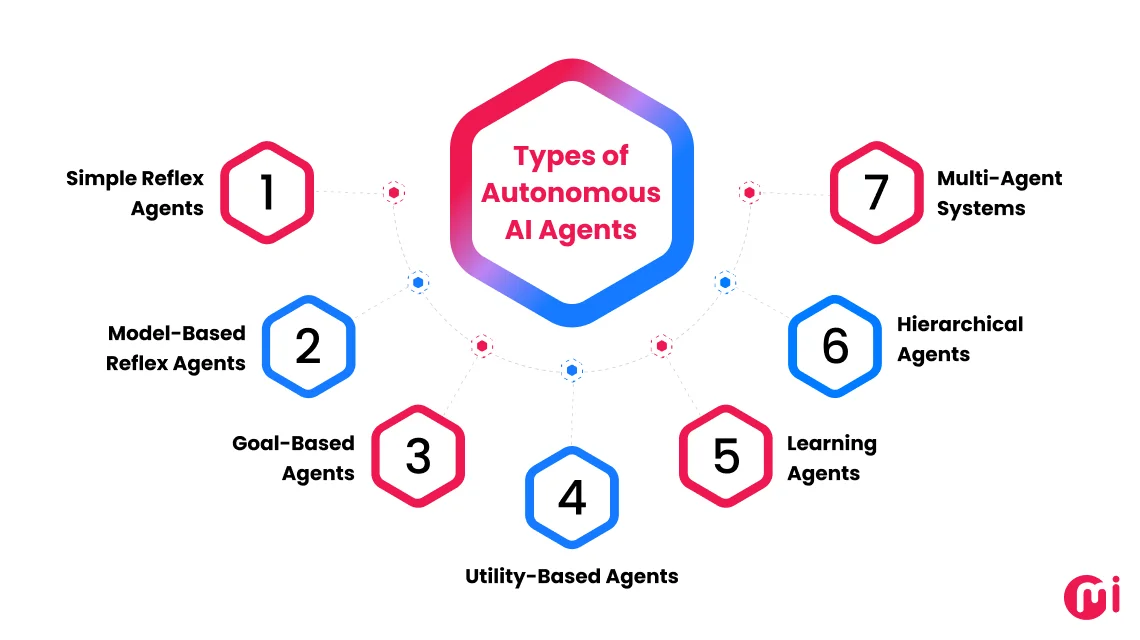

1. Simple Reflex Agents
Simple reflex agents act solely on the current perceptions of the environment (what they sense right now), following predefined condition-action rules. They lack memory and cannot learn or adapt from experience; hence, predefined rules might sometimes be insufficient upon induction of new situations, inducing repetitive mistakes. They are fast and reactive.
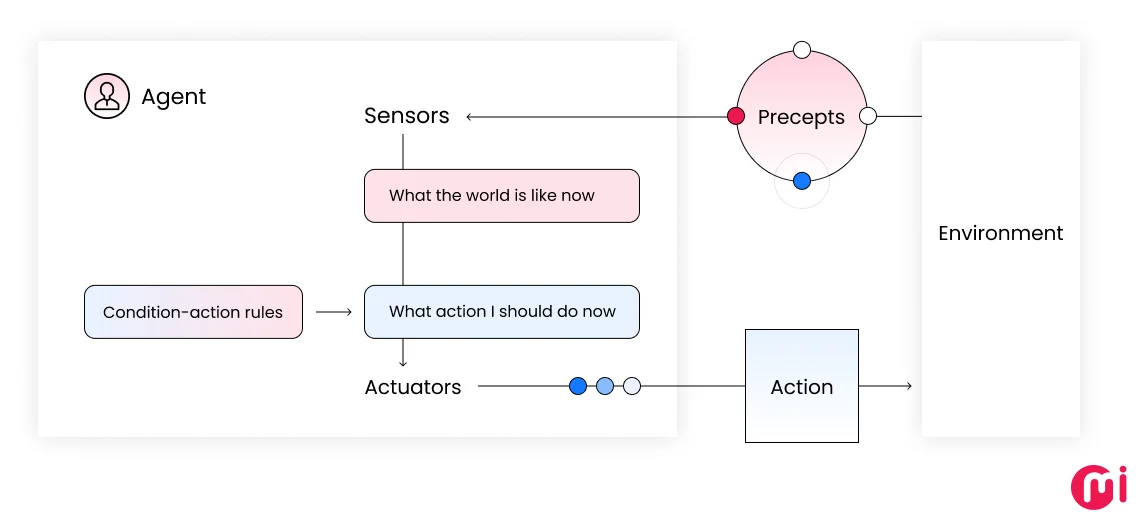

Weakness:
- Poor in complex or dynamic environments.
Real-world examples of simple reflex agents:
- Thermostats: Turn heating or cooling on/off based on the current temperature.
- Automatic Doors: Open when a person is detected in front of them
2. Model-Based Reflex Agents
Model-based reflex agents maintain an internal model of the world, allowing them to track the (past) states of the environment that are not immediately observable. Using an internal model to reason enables these agents to make more informed or context-aware decisions. Hence, model-based reflex agents can handle partial observability and are more flexible and intelligent than simple reflex agents.
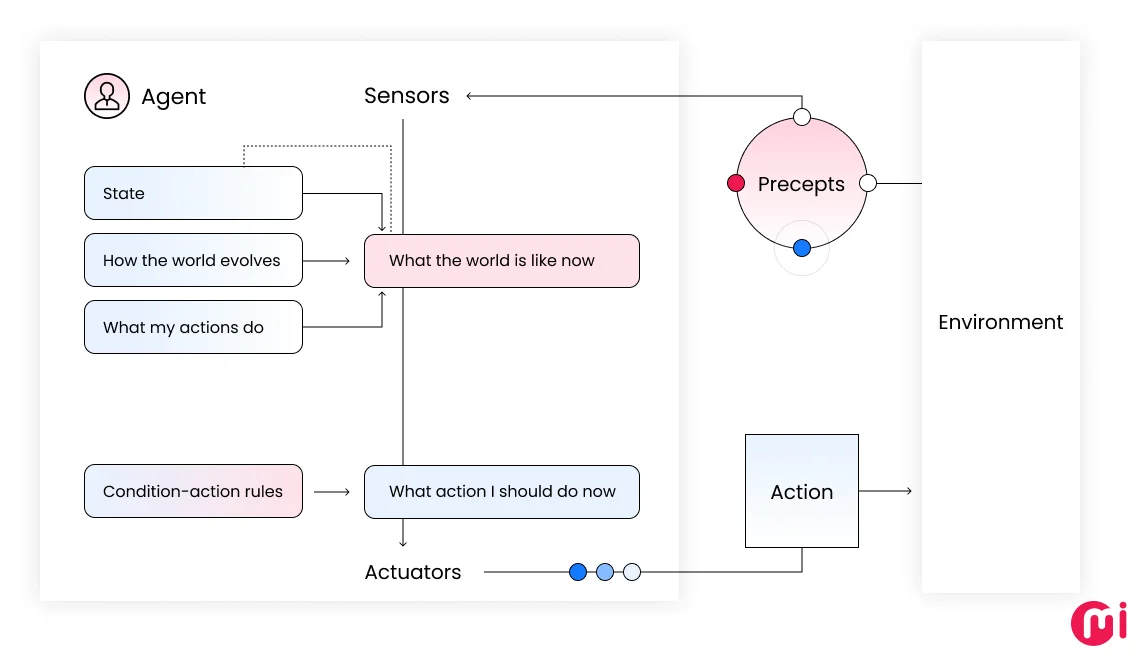

Weakness:
- Lacks advanced reasoning and learning capabilities.
Real-world examples of model-based reflex agents:
- Self-Driving Cars: Use internal models to track road conditions and other vehicles and predict future states for safe navigation.
- Robot Vacuum Cleaners: Some advanced models map the rooms and remember which areas have been cleaned.
3. Goal-Based Agents
Goal-based agents act to achieve specific goals, evaluating possible actions and choosing those that bring them closer to their objectives. They use planning and reasoning to adapt as circumstances change, hence extending the capabilities of the simple reflex agent.
Goal-based models have greater foresight, so they can plan ahead. They are proactive in behavior.
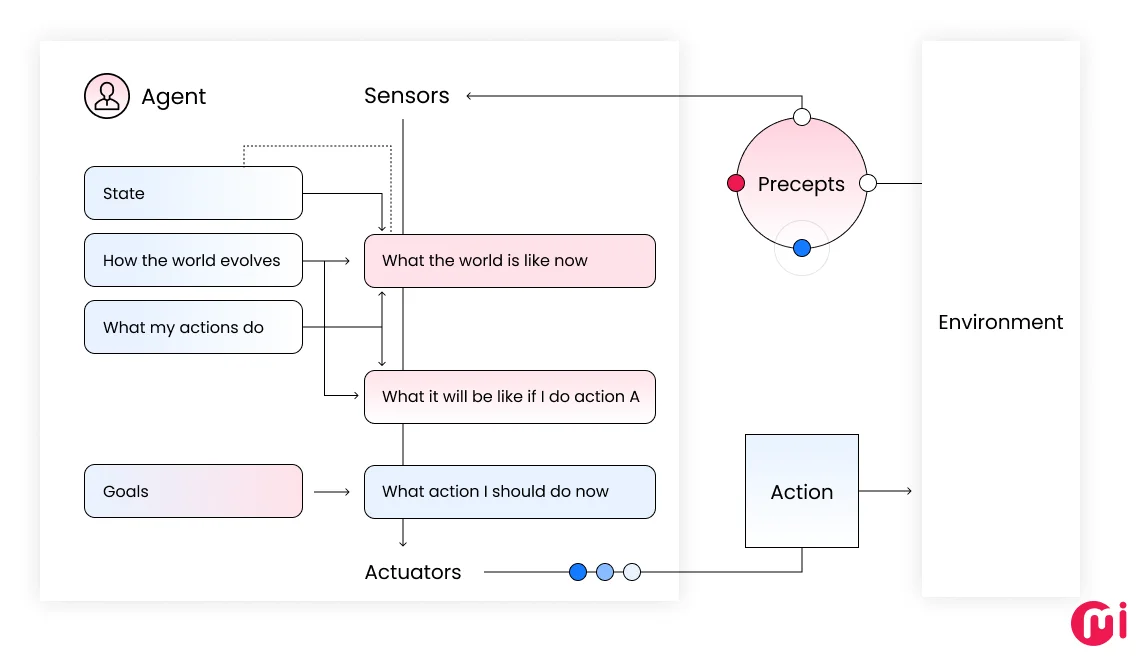

Weakness:
- Requires goal representation and planning capabilities. Relies on preprogrammed strategies or decision trees for goal evaluation.
Real-world examples of goal-based agents:
- Fitness Apps: Set and track user fitness goals, suggesting personalized workouts and diet plans to achieve them.
- Navigation Systems: Plan routes to reach a destination, recalculating as needed to plan optimal routes if conditions change (e.g., Google Maps).
4. Utility-Based Agents
Utility-based agents choose actions based on a utility function, aiming to maximize overall satisfaction or value, often balancing multiple or competing objectives. Unlike goal-based agents, which fulfill the defined goal, utility-based agents evaluate trade-offs between goals to determine the most optimal course of action that maximizes utility in situations where multiple conflicting goals or uncertainty is involved.
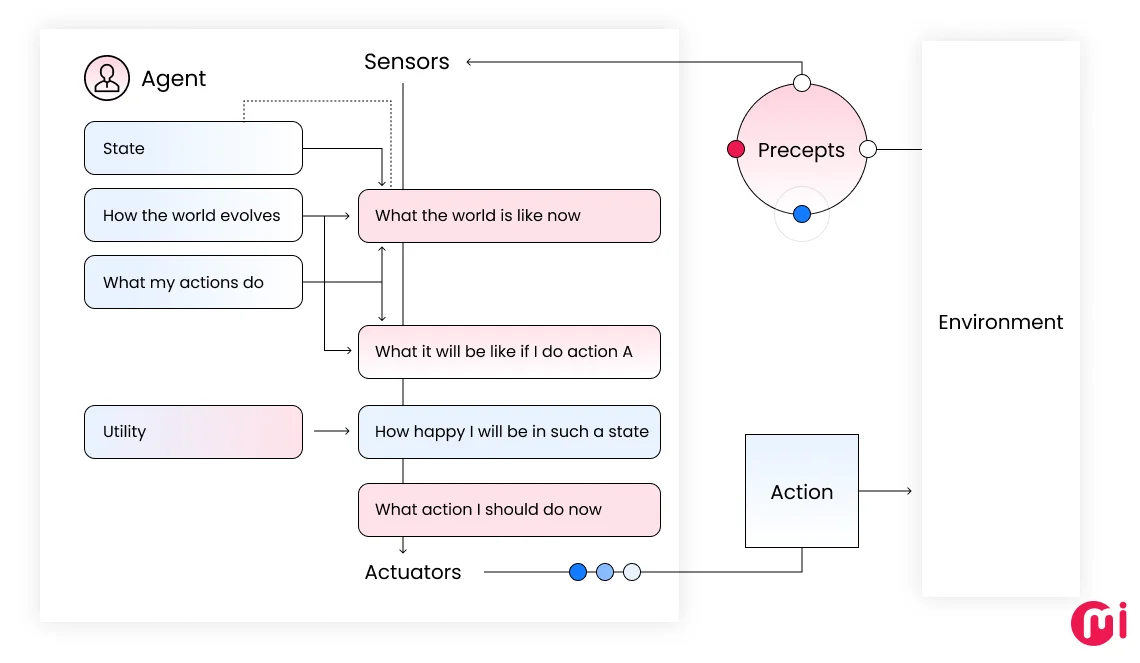

Weakness:
- Complex to define utility function accurately; expensive computational cost.
Real-world examples of utility-based agents:
- Recommendation Engines: Suggest products or content to maximize user engagement and satisfaction (e.g., Amazon’s recommendation system).
- Self-Driving Cars: Balance safety, speed, fuel efficiency, and passenger comfort to maximize driving utility (e.g., Tesla Autopilot).
5. Learning Agents
Learning agents improve their performance over time by learning from experience, feedback, or data. They can adapt to new or unforeseen situations; hence, they are self-improving and can operate well in complex and ever-changing environments.
They often use machine learning techniques such as reinforcement learning, supervised learning, or unsupervised learning.
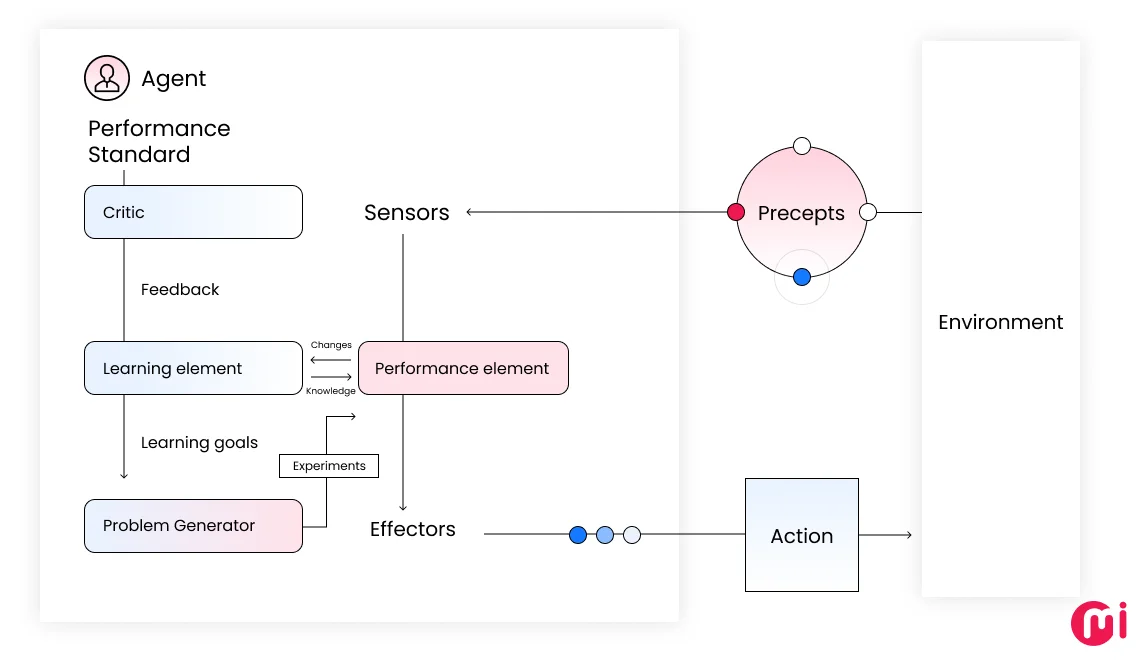

Weakness:
- Requires training data and time. Risk of overfitting or underfitting.
Real-world examples of learning agents:
- Financial Robo-Advisors: Provides fully automated financial advice and portfolio management (e.g., Wealthfront).
- Autonomous Robots: Navigates complex environments, performs inspections, and carries out tasks autonomously (e.g., Boston Dynamics’ Spot Robot).
6. Hierarchical Agents
Hierarchical agents organize decision-making in layers (multiple levels of abstraction), with each level handling tasks of different complexity or time scales. It uses a top-down control flow, where higher-level agents oversee or coordinate lower-level agents. Hence, it allows operational authorities to break complex processes into simpler subtasks.
The hierarchy of layers comprises the high-level (or top-level) (deliberative layer), mid-level (sequencing layer), and low-level (reactive layer).
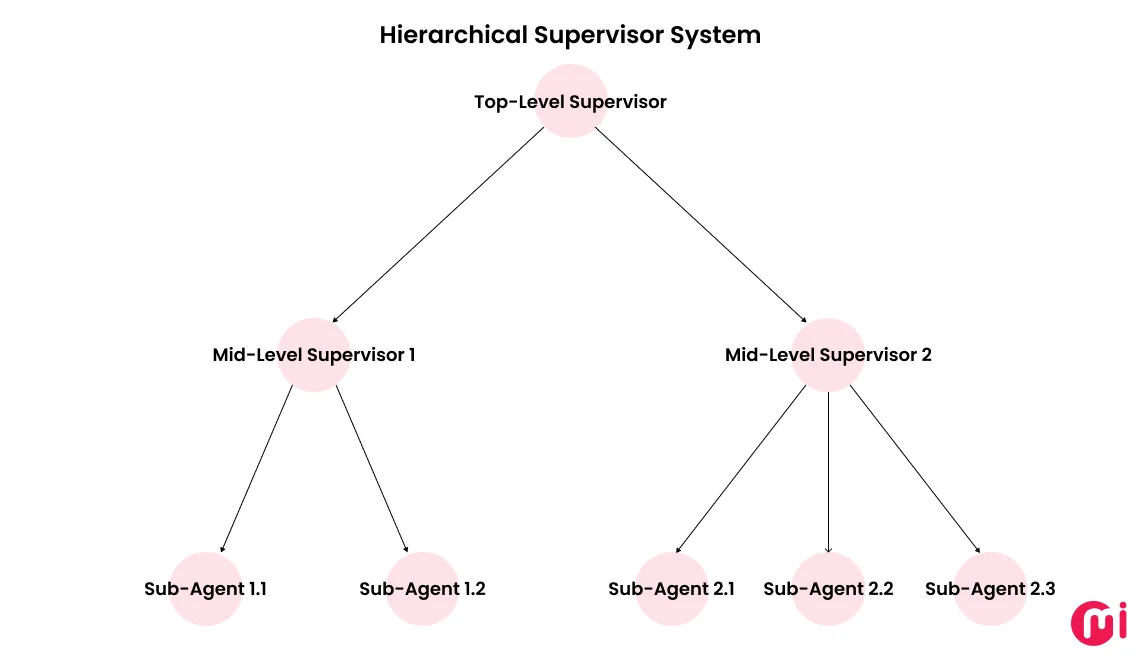

Weaknesses:
- Integration challenges between layers. Coordination between layers can fail if lower-level modules override important high-level goals
Real-world examples of hierarchical agents:
- Enterprise Workflow Automation: High-level agents manage processes, delegating subtasks to specialized sub-agents (e.g., in large-scale business operations).
- Smart Factories: High-level agents manage production schedules and operations, and low-level agents control individual machines and conveyor belts.
7. Multi-Agent Systems
Multi-agent systems (MAS) consist of multiple interacting autonomous agents, which may cooperate, compete, or operate independently to achieve goals. With the increase in complexity of the tasks, the requirement arose to break down these tasks into smaller, more manageable ones; hence, multi-agent systems came into existence. Each agent has its sensors, goals, and behaviors. Agents can communicate, coordinate, or negotiate.
These agents are highly scalable and decentralized. They offer robustness through redundancy and parallelism.
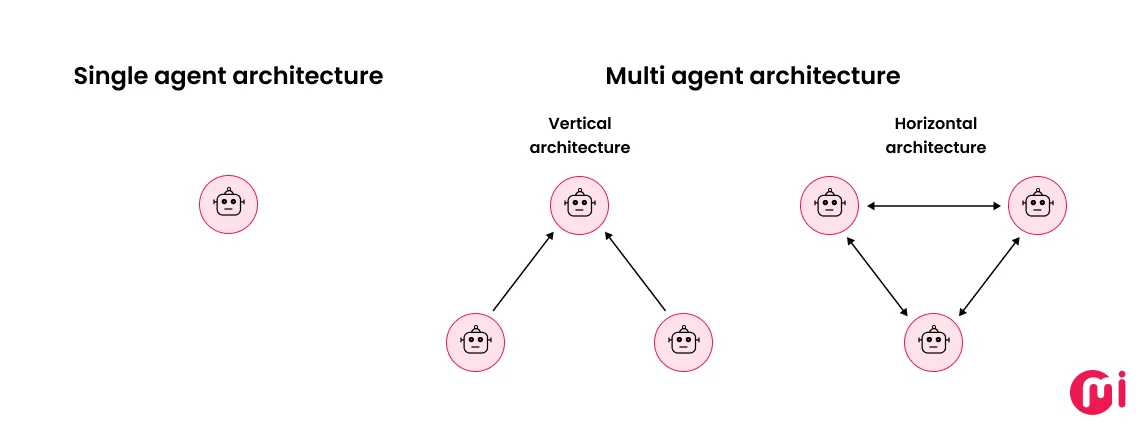

Weaknesses:
- Coordination complexity—possibility of conflict, deadlock, or unpredictable emergent behaviors
Real-world examples of multi-agent systems:
- Supply Chain Optimization: Agents can represent suppliers, warehouses, and any such aspect of the supply chain. These agents coordinate activities from procurement to delivery, optimizing processes and reducing costs.
- Traffic Management: Traffic signals, surveillance cameras, and traffic information systems each act as autonomous agents. These agents communicate and coordinate to optimize traffic flow, reduce congestion, and respond to incidents like accidents or road closures.
Real-World Applications of Autonomous AI Agents Across Industries
AI autonomous agents are used in self-driving cars, financial trading bots, healthcare diagnostics, virtual customer service assistants, warehouse automation, cybersecurity monitoring, AI tutoring, and more. They help automate complex tasks, improve efficiency, and reduce human workload across various sectors.
Let’s explore some of the widely adopted real-life examples of autonomous agents.
Healthcare
One of the prominent examples of organizations adopting AI in healthcare, especially autonomous agents, is Cleveland Clinic. It launched a customer-facing autonomous AI agent that is designed to free up the staff from time-consuming tasks like scheduling appointments, managing prescriptions, handling bill payments, sending refill reminders, resolving insurance inquiries, collecting pre-bit forms, and more.


Retail
Whether it’s using AI in inventory management, supply chain management, customer service, or so, retail is one of the industries that has intentionally benefited from autonomous agents.
Amazon warehouse is leveraging automation in various aspects, from managing stock replenishment to minimizing waste, using hundreds of autonomous agents. Similarly, Walmart is also one of the companies that has leveraged AI integration services in its inventory management for monitoring shield inventory, excess inventory, and more.
Explore in detail the impact and benefits of using AI in supply chain management.
Finance
Autonomous agents have been successful in showcasing their potential even in industries like finance with potential risks associated with fraud, compliance, and more.
A leading financial institution, JP Morgan Chase, has also implemented AI autonomous agents named COiN Platform that are designed to assess contract risks, review legal documents, and more. This platform helps the company to accelerate the process of risk assessment and compliance.
Real Estate
In real estate, autonomous AI agents assist with property valuation, lead generation, virtual tours, automated client communication, contract management, and market trend analysis. They streamline operations, enhance customer experience, and help autonomous agents make faster, data-driven decisions.
Popular online real estate marketplace Zillow has also invested in technologies like AI, machine learning, natural language processing, and more to offer AI-powered capabilities in their online marketplace—making property searches easier for customers, providing personalized home recommendations, and more.Explore more about how agentic AI is changing real estate aspects like property search, market analysis, predictive investments, property valuation, and the industry as a whole.
Develop Autonomous AI Agents in Collaboration with MindInventory
At MindInventory, we go beyond AI agent prototypes—we deliver production-grade, autonomous agents built for scale. Our wide range of AI development services includes AI consulting, custom ML development, and more.
From healthcare to finance, hire our ML engineers for architecting multi-agent frameworks capable of solving highly specialized, high-stakes challenges.
One of our agentic AI initiatives involves deploying a multi-agent architecture for medical document analysis, pushing the boundaries of what intelligent automation can do in the healthcare sector. With this initiative, we are looking forward to enabling organizations to leverage multi-agent systems—including frameworks like Google’s ADK and CrewAI—to solve complex problems such as medical document analysis, structured data extraction, and validation of clinical conditions.
Whether you’re starting from scratch or scaling autonomous AI agents across your org, we’re here to help. Let’s build something intelligent, something autonomous. Talk to our AI experts.
FAQs on Autonomous AI Agents
The key difference between autonomous and AI agents lies in their level of autonomy and independence. AI agents are systems that use artificial intelligence to perceive and act within an environment. Autonomous agents can operate independently without human intervention, making decisions and taking actions on their own. All autonomous agents are AI agents, but not all AI agents are autonomous.
Autonomous AI agents are a step toward artificial general intelligence (AGI), but they are not AGI themselves. They can perform specific tasks independently, but AGI would require the ability to understand, learn, and apply knowledge across a wide range of tasks like a human. Autonomous agents show progress, but true AGI remains a future goal.
The main 5 types of AI agents are simple reflex agents, model-based reflex agents, goal-based agents, utility-based agents, and learning agents.
As of now, the 4 most recognized AI agents are ChatGPT (OpenAI), Gemini (Google DeepMind), Claude (Anthropic), and Copilot (Microsoft/GitHub).
An example of autonomous AI is Tesla’s Autopilot and Full Self-Driving (FSD) system. It uses sensors, machine learning, and decision-making algorithms to navigate roads, change lanes, and park with minimal or no human input.






